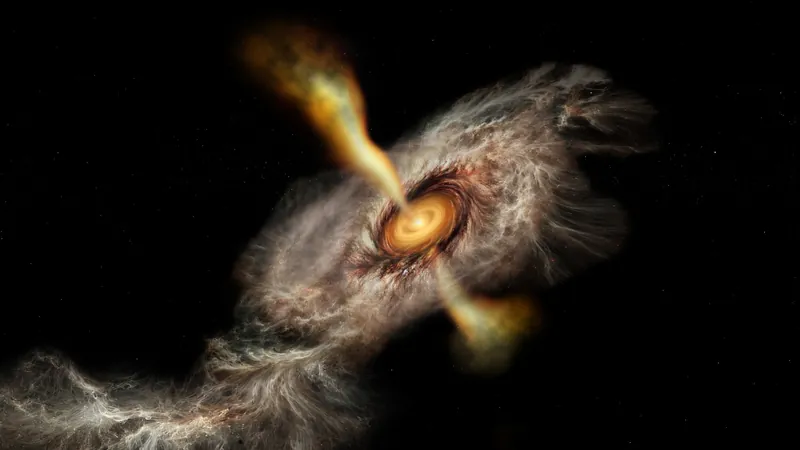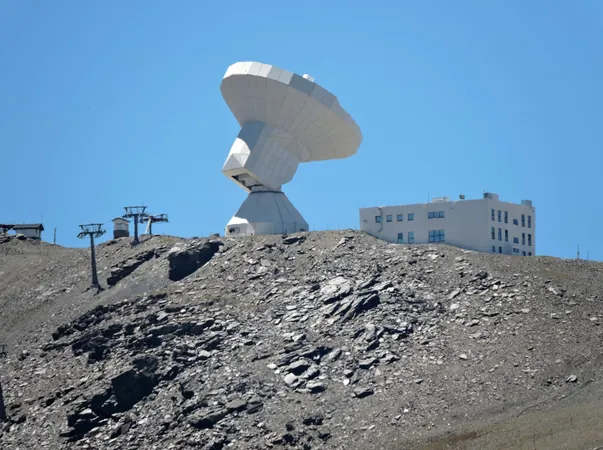
Astronomers Unveil a Cosmic Giant: A Star Devouring Two Jupiter Masses Annually!
2025-05-16
Author: Sarah
Astronomical Discovery: The Rapid Growth of HW2
In a stunning breakthrough, astronomers have captured the clearest images ever of a massive young star, HW2, voraciously consuming swirling gas from its surroundings. This remarkable sight offers an unprecedented look into the formation of these astronomical giants, which can reach up to 20 times the mass of our sun.
HW2: A Stellar Behemoth 2,300 Light-Years Away
Located roughly 2,300 light-years from Earth in the star-forming region known as Cepheus A, HW2 is enveloped in dense clouds of dust that typically shroud such areas from our view. However, researchers have managed to pierce this veil, uncovering the intricate processes driving the star’s rapid expansion.
Understanding Cosmic Growth: The Role of Gas and Dust
Harnessing the power of radio observations, specifically focusing on ammonia—an abundant molecule in interstellar space—the astronomers mapped the swirling disk of gas and dust around HW2. Their findings, set to be published in *Astronomy & Astrophysics*, reinforce the principle that massive stars generate their colossal mass through the same methods as smaller stars: by accumulating gas from these swirling disks.
The Research Team and Their Methods
Led by Alberto Sanna from the National Institute for Astrophysics in Italy, the team utilized the renowned Very Large Array radio telescope network in New Mexico back in 2019. By tracking ammonia's radio signals, they bypassed the dense dust clouds, allowing them to observe the star’s nearest processes closely.
Astounding Growth Rate: Two Jupiter Masses Per Year!
The data collected revealed a staggering rate of gas inflow from HW2’s accretion disk, with the star acquiring mass at an extraordinary pace of about two Jupiter masses per year—one of the highest growth rates witnessed in stellar evolution!
Environmental Factors Affecting HW2's Growth
Sanna pointed out that HW2's development hinges on its immediate cosmic environment. The research showed a striking imbalance in gas distribution within its accretion disk: the eastern hemisphere is packed with twice as much gas as the western hemisphere, showing signs of heightened turbulence.
Cosmic Supply Lines: The Role of Gas Streams
This intriguing asymmetry suggests that HW2 might be receiving material from an external source, potentially a nearby filament of gas and dust. This discovery reinforces the theory that such filaments serve as cosmic supply lines, funneling fresh materials to young stars and aiding in their relentless growth.
Future Prospects: Predicting HW2's Development
While the team has not yet been able to directly observe these feeding streams, they’ve laid down predictive frameworks for upcoming research. Sanna emphasized the necessity to understand how long HW2 can sustain its monumental growth: "The mystery of this cosmic giant continues to unfold, promising exciting revelations in stellar formation and evolution!"

 Brasil (PT)
Brasil (PT)
 Canada (EN)
Canada (EN)
 Chile (ES)
Chile (ES)
 Česko (CS)
Česko (CS)
 대한민국 (KO)
대한민국 (KO)
 España (ES)
España (ES)
 France (FR)
France (FR)
 Hong Kong (EN)
Hong Kong (EN)
 Italia (IT)
Italia (IT)
 日本 (JA)
日本 (JA)
 Magyarország (HU)
Magyarország (HU)
 Norge (NO)
Norge (NO)
 Polska (PL)
Polska (PL)
 Schweiz (DE)
Schweiz (DE)
 Singapore (EN)
Singapore (EN)
 Sverige (SV)
Sverige (SV)
 Suomi (FI)
Suomi (FI)
 Türkiye (TR)
Türkiye (TR)
 الإمارات العربية المتحدة (AR)
الإمارات العربية المتحدة (AR)